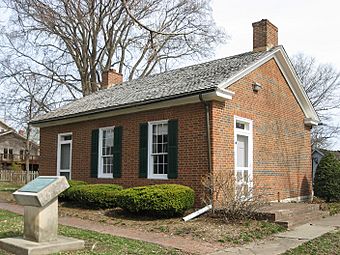John Hay Center facts for kids
Quick facts for kids |
|
|
Hay-Morrison House
|
|
|
U.S. Historic district
Contributing property |
|

Front and southern end of the house
|
|
| Location | Salem, Indiana |
|---|---|
| Built | 1824 |
| Architectural style | Federal |
| NRHP reference No. | 71000007 |
| Added to NRHP | October 26, 1971 |
The John Hay Center is a fantastic history park located in Salem, Indiana. It's a place where you can step back in time and learn about important people and how life used to be. The center is made up of several interesting parts, including old homes, a village that looks like it's from the 1840s, and cool museums. It's a great spot to explore the past and discover Indiana's history!
Discovering the John Hay Center
The John Hay Center is a collection of historic buildings and exhibits. It helps visitors understand what life was like in the 1800s. The center was created because a local person, Everett Dean, loved history. He wanted to share the past with everyone.
The Hay-Morrison House
The Hay-Morrison House is a very special building at the center. It was the birthplace and home of John Hay. He was a very important person in American history. John Hay worked as the private secretary for President Abraham Lincoln. Later, he became the Secretary of State for Presidents William McKinley and Theodore Roosevelt. This means he helped guide America's relationships with other countries.
The house was bought by John Hay's father, Dr. Charles Hay, in 1837. In 1967, the Washington County Historical Society bought the house. They worked hard to restore it. Now, it looks just like it did in the 1840s. The Hay-Morrison House has been recognized as a historic place since 1971.
Exploring Pioneer Village
The Pioneer Village is like a "living village" at the John Hay Center. It shows what a typical Indiana village looked like in the 1840s. Many of the buildings here are original or built with old materials.
- The general store and post office were moved from New Philadelphia, Indiana.
- Other buildings, like the blacksmith shop, cabin, church, and school, were built using logs from old Washington County homes.
- You can see a bell tower, a carpenter's shop, a jail, a loom, and a smokehouse. It's a great way to imagine daily life long ago!
The Stevens Memorial Museum
The Stevens Memorial Museum was built in 1970. It used materials, especially bricks, from several other historic buildings in the area. This museum holds many important items from Indiana and American history. It also has a special area for people to research their family history.
Inside the museum, you can see different exhibits. There's a display of an old dentist's office. You can also learn about a local candy maker. There are even exhibits about lawyers from before the American Civil War. The museum has grown over the years, with new parts added in 1984 and 1995.
The Depot Railroad Museum
The Depot Railroad Museum looks like the old train station that was burned down in 1863. This happened during the American Civil War by soldiers led by John Hunt Morgan. The museum is filled with items related to railroads. It also has large pictures showing the landscape of Washington County, Indiana from long ago.
One interesting item is a money chest. Morgan's Raiders checked this chest for money. When they found only tools, they burned the depot down. The museum was opened on September 22, 2001. A retired newspaper editor, Cecil Smith, helped make it happen. His collection of railroad items became the basis for the museum. Many people and students helped move model trains into the new building.
The John Hay Center is special because no money was ever borrowed for its improvements. Everything was paid for with money that was already available. This shows how much the community cared about preserving its history.
Gallery
See also







